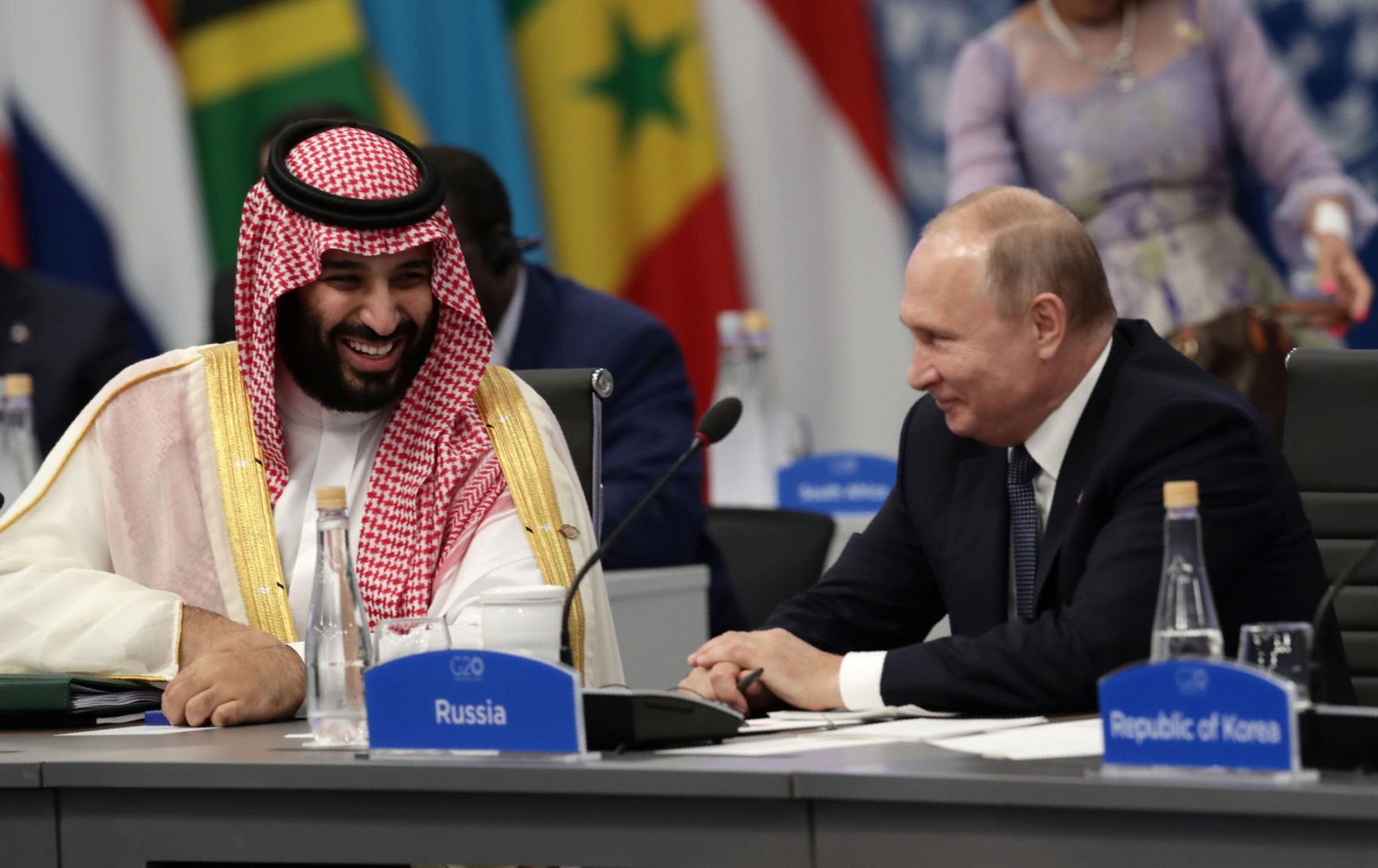The oil market’s bearish turn in recent months triggered a nearly 30% drop in prices for Brent crude between early October and the end of November. The reasons for such bearishness? A mix of unexpected US sanctions waivers for major importers of Iranian crude; continued increases in US shale production; higher production levels in Saudi Arabia; and weakening demand outlooks for 2019.
Seeking to stabilize the market and preserve revenues, Russia and Saudi Arabia have worked together to broker a deal with the rest of OPEC. The deal struck between OPEC members has been to cut a combined 1.2 million barrels of oil production per day in 2019. Details, though, remain scarce.
Heightened Russia-Saudi cooperation is unsurprising in this regard. Top level warmth between Vladimir Putin and Mohammed bin Salman during the Buenos Aires G20 Summit underscores an eagerness for that cooperation to go further. But their shared resolve to use cuts in the name of market stabilization belies twin pressures beyond their control: US shale production and weaker oil demand growth.
The Russia-Saudi oil entente is simple. Both are facing market constraints for which it is better to do something than nothing. Yet time may be running out. The utility of recurring production cuts to prop up prices is diminishing. And the market has proven more volatile than in the past.
Supply and demand are very rarely “balanced” on oil markets. Historically that creates a price cycle affected by waves of investment into new supply when prices rise high enough. The psychological whims of investors can also take their toll. US shale production is reactive to price changes and moves fast. This can unsettle the market by shortening how soon supply responds to demand.
US Production Pressures
The OPEC+ production cuts helped stabilize oil inventories and demand. But US oil production reached 11.7 million barrels per day (bpd) by late November. This was up from its post-2014 low of 8.5 million bpd in September of 2016. The US now produces more oil daily than Russia or Saudi Arabia; and the general consensus on future US production is strong. BP’s most conservative scenario from its 2018 World Energy Outlook sees more than 2 million more barrels a day coming onstream by the early 2020s. Goldman Sachs expects that shale will continue to drive global production growth through 2023.
Yet, US production faces some constraints. The generally agreed upon figure assumes that roughly 2 million barrels per day (bpd) of extra pipeline capacity for oil fields in the Permian basin – Texas and the edge of New Mexico – will be done by 2020. US producers see reduced profit margins due to the domestic oversupply of oil. The West Texas Intermediate (WTI) – the dominant US crude benchmark for export – trades around $9 less than Brent crude prices right now.
$50 is a good yardstick for the break even price for US producers. Lower prices are beginning to negatively affect capital investment plans. This is especially so for firms with rising costs as wells deplete or produce at lower rates. That will lower production growth. But US exports are currently at roughly 2.4 million bpd, and some project that figure to rise to 3.9 million by 2020. As more pipelines and terminals for export are built in the next 18 months, the spread between WTI and Brent will likely narrow. So price increases for Brent via cuts may not help Russia or Saudi Arabia. Instead they could usher in an accelerating cycle of price increases and decreases come late 2019.
The Price Trap
Putin has stated that oil prices around $60 a barrel are “fair and balanced.” It is a stance which allows major firms to maintain operations at a profit. And that price is low enough to prevent consumers from cutting their oil usage. $60 a barrel functions as a psychological reference point for investors and the OPEC+ countries that agreed to the cuts.
For Russia, $60 is a good deal. The budget this year used $50 a barrel as a benchmark to avoid deficit, and the Ministry of Finance set $40 a barrel as the breakeven point for revenues and expenditures in 2019. Russian firms are well positioned thanks to higher prices earlier in the year.
Despite that, an extended price drop well below $60 would deny Moscow extra revenues to spend on various key political initiatives. These were launched after Putin’s inauguration to fulfil national goals set out in his May Decrees this year. Corporate interests vary. But most would prefer to fight for market share so they can earn something back after sinking large upfront investments into new oilfields.
Saudi Arabia needs a price closer to $70 a barrel to break even on its budget. But unlike Russia, it faces no trouble raising debt abroad. The Kingdom has larger cash reserves on hand to afford deficits. Raising prices above where they are now is more a matter of stability for oil markets, an attempt to create sustainable conditions for oil sector investment and consumers.
The real problem for Moscow and Riyadh is that “stability” for the market at $60 a barrel or higher leaves space for US shale producers. The strategy of coordinating cuts based on those price assumptions, particularly as spreads for WTI decrease, may manage the market in the near term. But weaker demand worsens the challenge they face.
Weakening Demand
Global improvements in energy efficiency and declining energy intensity for developing economies helped cause the 2014 oil shock. Less oil is needed to produce GDP growth as a result, a trend the Russian government expects to continue apace into the future.
Outlooks began to weaken in August when imports in India and China – the world’s two leading growth markets – declined nearly 500,000 bpd in July compared to January-July averages. In September, world demand was expected to rise past 100 million barrels per day. But OPEC noted various economic and political pressures on demand for 2019. As of November, it had revised its demand projections downward 4 months in a row. Even the most bullish investment banks have begun to revise their 2019 price projections downward.
Russia and Saudi Arabia quietly increased production in September to make up lost Iranian exports thanks to US sanctions. Brent crude prices peaked at almost $87 a barrel in part due to fears about the complete loss of Iranian exports from the market. When the US chose to issue waivers, there were hundreds of thousands of unexpectedly excess barrels available. It helped drive a large selloff of oil futures due to a mental shift towards economic concerns.
The OECD had warned in September that global growth had peaked. Political risks and concerns about growth in emerging markets now psychologically dominate the outlook for oil demand next year. Whether that is slowing global growth or specific risks in key emerging markets. Lower prices are not driving up demand. They’re dovetailing with weak demand growth, putting Russia and Saudi Arabia in a tough position.
The Myth of Sisyphus
It’s early to tell what effect cuts would have since no hard figures have yet emerged, but the announcement has inched up prices. Undertaking another cut – now aided by word of a 325,000 bpd cut in Alberta – appears to be taking on a Sisyphean task. Inventories may rebalance and prices may edge up. US producers that are highly reactive to price changes will then clamor to extract and export more. Prices will then drop in response.
This dynamic will also be constrained by improvements in renewable energy and electric cars. These will lower the price ceiling at which consumers begin to alter their consumption habits in future. Most analyses seem to place it somewhere between $80 and $90 a barrel. Russia and Saudi Arabia will then be stuck going back and forth on cuts while demand growth slows. That situation isn’t sustainable. Demand outlooks can’t plan for lost demand due to global recession and political risks.
Even if US production peaks in the early 2020s, it will continue to increase the volatility of oil markets. Though both have greater reason to coordinate their efforts for now, cuts will eventually hurt their bottomline. Higher prices encourage investment into non-OPEC oilfields and Russian projects are sanctioned, threatening their respective shares of the global market.
The cycle won’t end and may even speed up if demand growth weakens in the future. .










